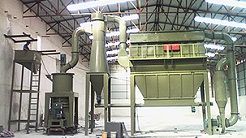Grinding Technology of Common Minerals
Source: clirik By Administrator Posted: 2023-03-02Mineral processing is to remove impurities and improve product purity; second is to reduce the particle size of products to varying degrees. At present, domestic and foreign crushing, grinding and grading technology and equipment have developed to a new level, which can meet the application needs of most raw materials in different industries, including non-metallic minerals, cement, ceramics, chemicals, coal powder, metal minerals, tailings Solid waste and so on.
Calcium carbonate
At present, the production of heavy calcium carbonate is mainly based on grinding and surface modification. The dry process is generally used to produce heavy calcium carbonate products with d97≥3-5μm. The crushing equipment mainly includes Raymond mill, impact mill, Dry stirring mill, jet mill, vertical mill, ring roller mill, vibration mill and ball mill, etc.
Quartz
Quartz is hard and wear-resistant, especially when fine grinding is required, it is difficult to obtain a grinding product with ideal fineness only by the grinding effect of the medium, so a certain amount of grinding aid is often added in the process of quartz grinding to improve grinding Effect.
Silica powder
The production of microsilica powder is mainly based on physical pulverization, which can be divided into dry process and wet process. The dry method product has a simple process and low production cost. Generally, microsilica powder manufacturers choose this process. Wet process is more suitable for ultra-fine products with cut point (large particle cut-off point) below 5 microns and requiring surface treatment.
Dolomite
Dolomite has a layered structure with a hardness of 3.5-4. Generally, jaw crushers, hammer crushers, and impact crushers are used to crush the ore. After screening and grading, dolomite pellets of a certain size are obtained. For fine crushing and grinding, roller presses, hammer mills, stirring mills and jet mills are often used.
Ceramic Raw Materials
At present, the preparation of raw materials in my country's ceramic enterprises basically adopts the ball milling process, which typically includes intermittent milling + intermittent milling, intermittent ball milling + continuous ball milling, vertical milling + intermittent milling or vertical milling + continuous milling.
Cement
At present, most cement plants use the combined grinding system composed of roller press and ball mill for production. The cement grinding system composed of roller press and ball mill includes pre-grinding system, combined grinding system and semi-finishing (double circle flow) There are three types of grinding systems, and the selection of the process flow mainly depends on the relative size of the roller press and the ball mill.
Limestone
Limestone is the main raw material for the production of cement, concrete coarse and fine aggregate, lime, etc. Its crushing and grinding generally adopt dry process, and the corresponding process is selected according to different application fields.
Fly ash
The particle size and particle shape of fly ash determine its application performance. Selecting the appropriate grinding process according to the physical and chemical properties of fly ash and the fineness requirements of the finished product is an important link in determining the economic value and processing cost of the finely ground ash.
Steel slag
Steel slag is industrial solid waste mainly composed of calcium silicate and calcium ferrite produced by converter steelmaking and electric arc furnace steelmaking. It is the best way to realize the high value-added utilization of steel slag by grinding steel slag as cement mixture or concrete admixture important way.
Slag
Blast furnace slag is a by-product discharged from the blast furnace ironmaking process. It has high potential activity. After it is independently ground to a certain fineness, it can replace cement in concrete in equal amounts and produce green synthetic cement. It can not only be used to prepare ordinary Concrete, but also one of the most commonly used mineral fine admixtures essential in high performance concrete.





